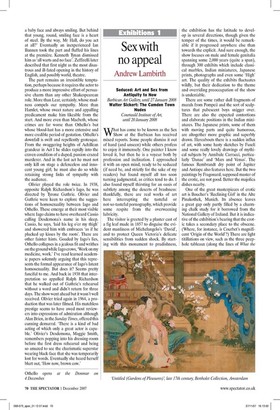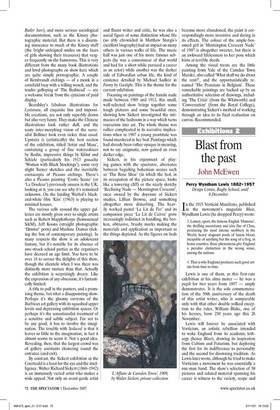Sex with no appeal
Andrew Lambirth Seduced: Art and Sex from Antiquity to Now Barbican Art Gallery, until 27 Januar), 2008 Walter Sickert: The Camden Town Nudes Courtauld Institute of Art, until 20 January 2008 What has come to be known as the Sex Show at the Barbican has received mixed reports. Some people dismiss it out of hand (and unseen) while others profess to enjoy it immensely. One painter I know loved it, but then he is a voyeur both by profession and inclination. I approached it with an open mind, ready to be seduced (if need be, and strictly for the sake of my readers) but found myself all too soon turning judgmental, as critics tend to do. I also found myself thirsting for an oasis of subtlety among the deserts of brashness: thankfully, there are real works of art here interrupting the tasteful or not-so-tasteful pornography, which provide some respite from the overweening lubricity.
The visitor is greeted by a plaster cast of a fig leaf made in 1857 to disguise the evident manliness of Michelangelo's 'David', and to protect Queen Victoria's delicate sensibilities from sudden shock. By starting with this monument to prudishness, the exhibition has the latitude to develop in several directions, though given the temper of the times, it would be remarkable if it progressed anywhere else than towards the explicit. And sure enough, the show focuses on male and female genitalia spanning some 2,000 years (quite a span), through 300 exhibits which include classical marbles, Indian miniatures, Japanese prints, photographs and even some 'High' art. The quality of the exhibits fluctuates wildly, but their dedication to the theme and overriding preoccupation of the show is undeniable.
There are some rather dull fragments of murals from Pompeii and the sort of sculptures that pubescent boys snigger over. There are also the expected contortions and elaborate positions in the Indian miniatures. The Japanese prints, some of them with moving parts and quite humorous, are altogether more graphic and superbly drawn. Hereabouts there is a sudden influx of art, with some hasty sketches by Fuseli and some really lovely drawings of mythical subjects by Annibale Carracci, particularly `Danae' and 'Mars and Venus'. The famous Rembrandt dry point of Jupiter and Antiope also features here. But the two paintings by Fragonard, supposed master of the erotic, are not good. Better the majolica dishes nearby.
One of the great masterpieces of erotic art is Boucher's 'Reclining Girl' in the Alte Pinakothek, Munich. Its absence leaves a great gap only partly filled by a charming chalk study for it borrowed from the National Gallery of Ireland. But it is indicative of the exhibition's bearing that the erotic takes a secondary place to the obscene. (Where, for instance, is Courbet's magnificent 'Origin of the World'?) There are light titillations on view, such as the three peephole tableaux (along the lines of What the Butler Saw), and more serious sociological documentation, such as the Kinsey photographic material. But there is a disarming innocence to much of the Kinsey stuff (the bright unfeigned smiles on the faces of girls showing their treasures) that verges frequently on the humorous. This is very different from the many book illustrations and lewd photographs on show here which are quite simply pornographic. A couple of Rembrandt etchings — of a monk in a cornfield busy with a willing wench, and the tender galloping of 'The Bedstead' — are a welcome break from the cynicism of paid display.
Beardsley's fabulous illustrations for Lysistrata, all exquisite line and impossible erections, are not only superbly drawn but also very funny. They make the Chinese illustrations look rather dull, and the nasty inter-morphing vision of the surrealist Bellmer look even sicker than usual. Upstairs is (artistically) the best section of the exhibition, titled 'Artist and Muse', containing a group of fine watercolours by Rodin, impressive things by Klimt and Schiele (particularly his 1913 gouache 'Woman with Black Stockings'), some very slight Turner sketches and the inevitable cornucopia of Picasso etchings. There's also a Picasso painting 'Erotic Scene' (or 'La Douleur') previously unseen in the UK; looking at it, you can see why it's remained unknown. On the landing Warhol's blackand-white film 'Kiss' (1963) is playing to minimal houses.
The various cells around the upper galleries are mostly given over to single artists such as Robert Mapplethorpe (homosexual S&M), Jeff Koons (straight photographic 'filmstaf porn) and Marlene Dumas (ticking the box of contemporary painting). In many respects the show is an adolescent fantasy, but it's notable for its absence of awe-struck school parties as the organisers have decreed an age limit. You have to be over 18 to savour the delights of this show, though the clientele when I was there was distinctly more mature than that. Actually the exhibition is surprisingly dreary. Like the expression of any obsession, it's fantastically limited.
A title to pull in the punters, and a promising theme, but what a disappointing show. Perhaps it's the gloomy environs of the Barbican art gallery with its squashed upper levels and depressing exhibition spaces. Or perhaps it's the sensationalist treatment of a sensitive and subtle subject. For sex to be any good, it has to involve the imagination. The trouble with Seduced is that it leaves so little to the imagination; in fact it almost seems to scorn it. Not a good idea. Revealing, then, that the largest crowd was of gallery assistants clustering round the entrance (and exit).
By contrast, the Sickert exhibition at the Courtauld is a feast for the eye and the intelligence. Walter Richard Sickert (1860-1942) is an immensely varied artist who makes a wide appeal. Not only an avant-garde artist and fluent writer and critic, he was also a social figure of some distinction whose life (so ably chronicled in Matthew Sturgis's excellent biography) had an impact on many others in various walks of life. The music hall was just one of his more famous subjects (he was a connoisseur of that world and had for a short while pursued a career as an actor) while another was the darker side of Edwardian urban life, the kind of existence detailed by Michael Sadleir in Fanny by Gaslight. This is the theme for the current exhibition.
Focusing on paintings of the female nude made between 1905 and 1912, this small, well-selected show brings together some tough pictures and some beautiful ones, showing how Sickert investigated the intimacies of the bedroom in a way which turns voyeurism into art. The whole theme was rather complicated in its narrative implications when in 1907 a young prostitute was found murdered in her bed. Paintings which had already been rather opaque in meaning, not to say enigmatic, now gained an even darker edge.
Sickert, in his enjoyment of playing games with the spectator, alternates between beguiling bohemian scenes such as 'The Rose Shoe' (in which the bed, in its occupation of the picture space, looks like a towering cliff) or the nicely sketchy 'Reclining Nude — Mornington Crescent', once owned by the doyenne of Sickert studies, Lillian Browse, and something altogether more disturbing. The heavily worked pastel 'Le Lit de Fer' and its companion piece 'Le Lit de Cuivre' grow increasingly indistinct in handling, the broken, obtrusive, brushy marks making the materials and application as important as the things depicted. As the figures on beds become more abandoned, the paint is correspondingly more inventive and daring in its effects. The colour of the ample-bosomed girl in `Mornington Crescent Nude' of 1907 is altogether sweeter, but there is an awkward lifelessness to her pose which hints at terrible deeds.
Among the visual treats are the little painting from Yale of the Camden Town Murder, also called 'What shall we do about the rent?', and the opportunistically renamed 'The Prussians in Belgium'. These remarkable paintings are backed up by an authoritative selection of drawings, including 'The Crisis' (from the Whitworth) and 'Conversation' (from the Royal College), demonstrating Sickert's method of working through an idea to its final realisation on canvas. Recommended.






































































 Previous page
Previous page